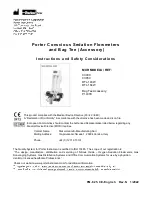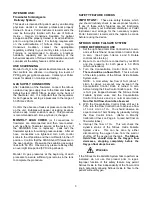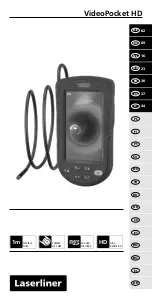
3
INTENDED USE:
Flowmeter for Analgesia
Delivery System
This device is intended for patient use by an attending
physician, dentist or licensed professional properly
trained in its use. Porter Instrument recommends the
user be thoroughly familiar with the use of Nitrous
Oxide - Oxygen Conscious Sedation for patient
analgesia and be properly trained in its administration
prior to using this product. For training requirements
on the administration of Nitrous Oxide - Oxygen
Conscious
Sedation,
contact
the
appropriate
regulatory authority in your country, state, or province.
Training is recommended to provide a practical,
hands-on capability and an understanding of the
behavioral aspects of Nitrous Oxide Sedation and will
complement the safety features of this device.
USE SCAVENGING
Monitor for N
2
O in the patient treatment area to insure
that controls are effective in achieving low levels of
PPM (parts per million) exposure. Contact your Porter
dealer for details on monitors and testing.
GAS SUPPLY CONNECTION
After installation of the flowmeter, connect the nitrous
oxide and oxygen supply lines to the Diameter Indexed
Safety System (DISS) fittings located on the back of
the flowmeter unit. It is important that the regulators
for both gases be set to give pressures in the range of
53 PSIG ±2 PSIG.
Confirm the absence of leaks at pressure connections
on the unit. Bubbles will appear at leaking locations
when a soap / water solution is used. This procedure
is recommended each time a cylinder is changed.
MONTHLY LEAK CHECK
(or if connections to
flowmeter are disconnected and then reconnected,
such as after a flowmeter service at the factory or if
the DISS/DISS hose is replaced): Leak test the
flowmeter system for working pressure leaks. After all
hose connections are tightened, turn both control
knobs to the off position and the on/off switch to the off
position. Confirm that the DISS Shut-Off Valves are in
the open position. Pressurize the sedation gas supply
lines with 50 PSI. Observe any pressure decay after
an overnight time period (5 PSI drop allowed
).
Monitor O
2
gas pressures at the beginning of each
procedure to assure sufficient gas remains in the tank
to complete the procedure.
SAFETY FEATURE CHECKS
IMPORTANT
:
These are safety features, which
you should routinely check to assure proper function.
If any of these safety features are not functioning
properly, contact your authorized distributor or Porter
Instrument and arrange for the necessary repairs.
Porter Instrument recommends the repairs be made
before reusing the device.
NITROUS OXIDE FAILSAFE SYSTEM
CHECK BEFORE EACH USE
1. Set the right-hand total Flow Control Knob to zero
and set the left-hand Concentration Control Knob
to zero. (See Figure 1-Items 4 and 5: Rotate
control knobs to stop.)
2. Be sure O
2
and N
2
O are connected to your MXR
and line pressure for both gases is 50 PSIG
(which is standard).
3. Turn the Concentration Control Knob to 50%.
There should be no flow of N
2
O.
This is a check
of the static position of the Nitrous Oxide Failsafe
System valve.
NOTE: A momentary low flow of N
2
O (about 1
L/min for about a second) may be seen if the
Concentration Control Knob is turned to zero
before turning the Flow Control Knob to zero. This
is N
2
O gas trapped between the Nitrous Oxide
Failsafe System valve and the Concentration
Control Knob valve and is a normal occurrence.
No other N
2
O flow should be observed.
4. With the Concentration Control Knob still set to
50%, turn the Flow Control Knob to achieve a flow
of 3 to 4 L/min of O
2
. You should observe an
equal amount of N
2
O flowing by gradually turning
the Flow Control Knob. (Refer to Monthly
Calibration Check on Page 4, to read ball float on
flowmeter tubes.)
5. Interrupt the flow of O
2
. This will check the
dynamic status of the Nitrous Oxide Failsafe
System valve. This can be done by either
disconnecting the oxygen hose from the wall or
shutting off the oxygen at the tank.
The Nitrous
Oxide flow should drop as the Oxygen flow
decreases, stopping completely before the
Oxygen float drops to zero
.
W
ARNING
If the Nitrous Oxide Failsafe System fails to perform as
indicated, do not use this product prior to repair.
Improper function of this safety feature may permit
Nitrous Oxide to flow independently of the flow control
knob, potentially allowing Nitrous Oxide to flow to the
patient without Oxygen.


























